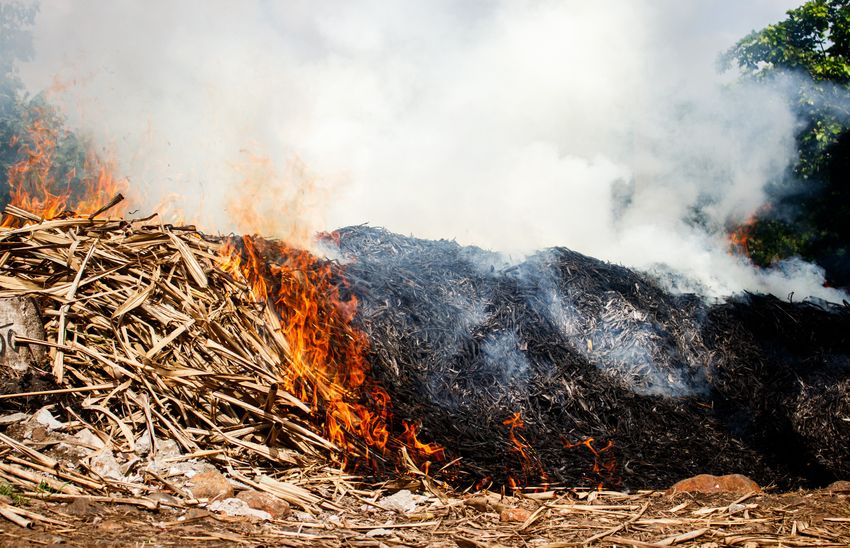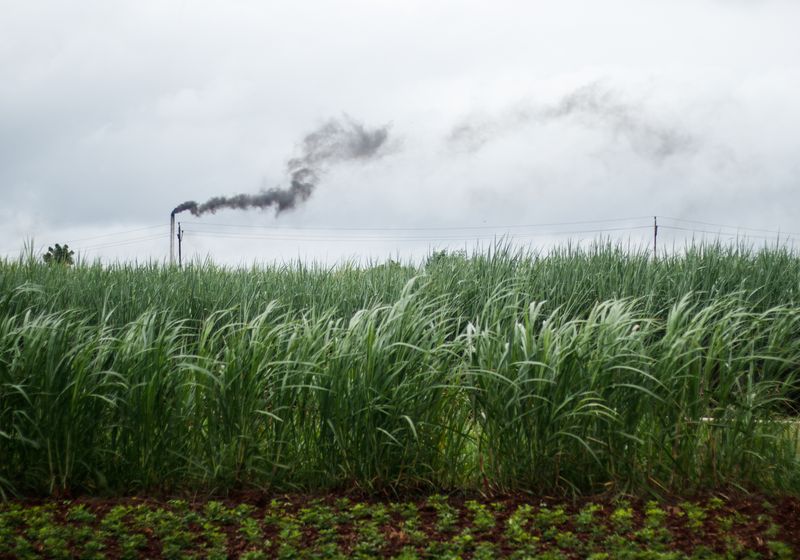Farmworker Rajendra Kamble points to the white-tiled floor of his house whenever someone asks about his worsening health.
By evening, the tiles turn grey with soot from the burning of agricultural residue in nearby sugarcane nurseries. After more than a decade of inhaling this smoke in Jambhali village of Western India, his health got much worse. He was diagnosed with type 2 diabetes mellitus (T2DM) seven years ago, followed by hyperthyroidism two years later.
“I am 55 now, but I feel much older,” he said. Doctors and community healthcare workers told him that constant exposure to polluted air was not only harming his health but also making him age faster.
Continuous exposure to factory emissions and smoke from farm residue is accelerating Rajendra Kamble’s (left) aging. His wife, farmworker Sunita Kamble (right), is making people aware of the mounting air pollution in their surroundings and its effects on aging.
Sanket Jain
“Many people are showing signs of premature aging,” said Chhaya Kamble, a healthcare worker from Ganeshwadi village in Western India, which is affected by severe air pollution. What once sounded anecdotal is now confirmed by research worldwide, indicating a shift in how scientists understand the effects of pollution on the body.
Long considered mainly a threat to the lungs and heart, air pollution is now emerging as a driver of biological aging at the molecular level. Scientists measure this through a process called epigenetic age acceleration, a type of molecular clock that examines chemical changes on DNA and indicates whether the body is aging faster or slower than expected for someone’s actual age. It helps predict the risk of developing age-related diseases such as cancer, heart disease, neurodegenerative disorders, or diabetes mellitus, among others. With air pollution’s role in accelerating aging, researchers are exploring interventions ranging from reducing emissions to using protective measures, while healthcare workers like Chhaya Kamble are trying to limit people’s exposure through local awareness and timely health check-ups.
Particulate Matter and Aging
Studies are beginning to reveal the impact of air pollution on aging in everyday life. In Australia, researchers found that pollutants from wildfire smoke can make the body age faster at the cellular level.1 Even small increases in the level of these particles—just one microgram per cubic meter, an almost invisible amount in the air we breathe—were linked to people aging a quarter to a third of a year faster.
Similar patterns have been observed elsewhere. In a large genetic study in China, researchers found that long-term exposure to particulate matter 2.5 microns or less in diameter (PM2.5), which are tiny particles in the air about 30 times smaller than a human hair, can accelerate aging.2 A protein called B-cell lymphoma 2 (BCL2), which manages cell survival and death, and a gene named metabolism of cobalamin associated B (MMAB), important for how cells produce energy, were both affected. Other research has also linked pollutants, especially nitrogen oxides like NO2, of sizes PM2.5 and PM10 (particulate matter that is 10 micrometers or smaller in diameter) to the risk of sarcopenia, a condition where muscles weaken and shrink.3 Sarcopenia accelerates aging by causing stress and damage in cells, impairing the cellular components that produce energy, making one vulnerable to frailty and diseases.
Long-term effects have also been documented. In Scotland, researchers studied 525 individuals born in 1936.4 Increased pollution exposure during birth and mid-life was linked to a higher epigenetic age, with effects such as shortened telomeres—markers of cellular aging—visible decades after the exposure.
Scientists in Taiwan realized that most existing epigenetic clocks were created using Western populations and might not fully reflect aging patterns in Asians. They then developed their own epigenetic calculator to measure the effect of long-term air pollution exposure on age acceleration in the Taiwanese population aged 30 to 70, studying over 2,400 participants.5 Air pollution exposure was estimated for participants in residential areas at different time windows, from the day before measurement up to one year. Long-term exposure to PM2.5 and ozone was associated with accelerated biological aging.
Air Pollution’s Effects on a Molecular Level
Alongside identifying the effects of different pollutants, scientists are now investigating the biological mechanisms through which air pollution accelerates aging.
Yao Wu, a postdoctoral research fellow at Monash University and coauthor of the Australian study, explained that when people inhale fine particles from wildfire smoke (PM2.5), it can lead to oxidative stress, mainly affecting lung epithelial cells and immune cells within and outside the lungs.6 This occurs when the body produces more unstable molecules than it can safely handle, potentially damaging cells. It can also cause chronic inflammation, which happens when the body’s defense system remains active for too long and gradually harms tissues. These processes, she said, are linked to changes in DNA methylation, chemical tags that control whether specific genes are active or inactive. If genes are turned on or off at the wrong times, over the long term this can affect how cells function and increase the risk of diseases.

Smoke from nearby farm residue burning frequently blankets Rajendra Kamble’s home, which he says has worsened his health.
Sanket Jain
Gergo Baranyi, a senior research fellow at University College London, who led the Scotland study, said, “We found that air pollution exposure around birth was particularly damaging.” He explained that in animal studies using rabbits, it has been shown that particles can translocate to the placenta and cause oxidative stress, disrupting the growth and development of the embryo.7
Baranyi and his colleagues found that because there are multiple air pollutants in the same source, it was difficult to separate the effects of each one. They found that sulfur dioxide SO2 (especially in the 1930s), PM2.5, and NO2 (from the 1980s) were strongly associated with accelerated biological aging.4
This emerging science resonates deeply with Rajendra Kamble’s experience. For 25 years, he worked in a textile mill, feeding wood into boilers to generate steam. “It would get unbearably hot, and the smoke started affecting my health,” he recalled. Eventually, he changed his profession.
His concerns about air pollution and T2DM aren’t unfounded, as a study involving more than 12,000 adults from two Indian cities observed that long-term exposure to PM2.5 increased the risk of developing T2DM.8 Researchers found that even a small rise in annual PM2.5 could increase the risk of developing T2DM by 22 percent.
Although Rajendra Kamble left the mill, his troubles remain. He now works as a farmworker in nearby villages, closer to polluting factories, where his exposure to harmful pollutants remains high.
Living in the Smog
When farmworker Vimal Chokake from Jambhali village turned 45, she began to feel much older. She was diagnosed with T2DM, and two years later with osteoarthritis. Now, at age 59, she said she can no longer walk.

Ever since Vimal Chokake, a farmworker from Jambhali village, turned 45, she said she felt like she was getting older much faster.
Sanket Jain
As the pain worsened over the years, she stopped working in the fields. She said that osteoarthritis has become so common that people in her village believe that once someone turns 40, they are likely to face joint problems. “Everyone seems to have accepted that falling ill is unavoidable.” Watching her own health decline, she said, “Each day, I feel like I’m aging too quickly.”
Studies from various countries hold answers to her rapid aging. Over a decade, researchers in Taiwan followed more than half a million adults. They found that long-term exposure to air pollution, such as carbon monoxide, NO2, and PM10, was associated with an increased risk of developing osteoarthritis.9
For over thirty years, Chokake cooked on a wood-fired stove, exposing herself to numerous pollutants. Even now, she boils water for bathing in a traditional water boiler, where cow dung cakes, firewood, or coal are burned, releasing PM2.5, CO, nitrogen oxides, SO2, black carbon, and volatile organic compounds, which are known to accelerate aging.10
New evidence from China suggests that exposure to pollutants from solid cooking fuels, such as biomass or coal, may contribute to premature aging and cognitive decline.11 It also links this accelerated aging to a striking 25 to 34 percent increased risk of neuropsychiatric disorders.
Many in her neighborhood also burn single-use plastic bags, releasing more harmful pollutants along with an overpowering stench. Chokake said, “We are now used to it.” When the pain becomes unbearable, she takes painkillers or an injection to reduce inflammation and ease movement. She worries that soon she may become dependent on medicine for even basic tasks.
Addressing Air Pollution Misconceptions
When 50-year-old Sunita Kamble, farmer Rajendra Kamble’s wife, was diagnosed with hypertension, she realized something needed to be done about the rising air pollution. “I knew the polluted air could someday affect my lungs, but I never imagined it could lead to hypertension,” she said.
For the past five years, she has spoken out against uncontrolled agricultural residue burning in the village, but her warnings about the dangers of air pollution are often ignored. Frustrated, she has started explaining to her neighbors how toxic air is silently accelerating aging. “Nearly every family in the village has at least one member who is affected by a cardiovascular disease, thyroid issues, or chronic illness at a young age,” she said.
A common misconception she faced was that inhaling air pollution couldn’t cause these diseases. She isn’t alone in this experience. Many healthcare workers also spend a lot of time correcting such misconceptions and educating communities. “I always give examples of people from the village about how they are losing their lives to different cancers, cardiovascular issues, and metabolic diseases,” said Kamble, the healthcare worker. She mentioned that during awareness sessions, people often tell her that it makes no difference if one person in the village stops polluting the air. She then replies that every small action counts, and that reducing pollution, even a little, can protect families, children, and older people.
When asked about common misconceptions, Wu pointed to one: That aging is fixed. “Our biology is much more dynamic. The epigenome, which regulates how our genes are expressed, is highly responsive to environmental factors,” she emphasized.
While exposure to wildfire smoke can accelerate biological aging, for example, certain protective behaviors may slow it down. “A single destructive wildfire season may be sufficient to trigger detectable changes in DNA methylation and epigenetic clock acceleration, particularly in susceptible individuals,” she said. However, she added that there is stronger evidence that long-term exposure to wildfire smoke, especially PM2.5, can build up over time. If repeated contact can speed up aging, exposure prevention could protect against it.
Wu recommended improving early warning systems for wildfire smoke, strengthening indoor air filtration, and promoting the use of masks. She also suggested maintaining a healthy lifestyle with regular physical exercise and a nutrient-rich diet.
However, even with these precautions, the harsh truth remains. “People say these are the diseases that happen because of aging, and strangely, everyone now seems to be aging much faster,” said Rajendra Kamble, noting that for most people, there’s simply no way to escape this toxic air.
- Wu Y, et al. Association between wildfire-related PM2.5 and epigenetic aging: A twin and family study in Australia. J Hazard Mater. 2024;481:136486.
- Xiao P, et al. Integrative genetic analysis to decode the causal effect of air pollution on accelerated aging. QJM. 2025; hcaf093.
- Liu X, et al. Exposure to air pollution, genetic susceptibility, and prevalence of sarcopenia in the UK. Ecotoxicol Environ Saf. 2024;285:117143.
- Baranyi G, et al. Life-course exposure to air pollution and biological ageing in the Lothian Birth Cohort 1936. Environ Int. 2022;169:107501.
- Huang CC, et al. Taiwan population-based epigenetic clocks and their application to long-term air pollution exposure. Environ Res. 2025;277:121542.
- Rizly S. Epidemiological and clinical evidence on the association between wildfire PM2.5 and pulmonary health outcomes. Cureus. 2025;17(8):e91239.
- Valentino S, et al. Maternal exposure to diluted diesel engine exhaust alters placental function and induces intergenerational effects in rabbits. Part Fibre Toxicol. 2015;13:39.
- Mandal S, et al. PM2.5 exposure, glycemic markers and incidence of type 2 diabetes in two large Indian cities. BMJ Open Diabetes Res Care. 2023;11(5):e003333.
- Chan YC, et al. A decade of exposure: Long-term air pollution and its impact on osteoarthritis: A nationwide cohort study in Taiwan. Osteoarthritis Cartilage. 2025
- Ward-Caviness CK, et al. Long-term exposure to air pollution is associated with biological aging. Oncotarget. 2016;7(46):74510-74525.
- Tang R, et al. The mediating role of accelerated biological aging in the association between household air pollution from solid cooking fuels and neuropsychiatric disorders. Ecotoxicol Environ Saf. 2024;289:117449-117449.

